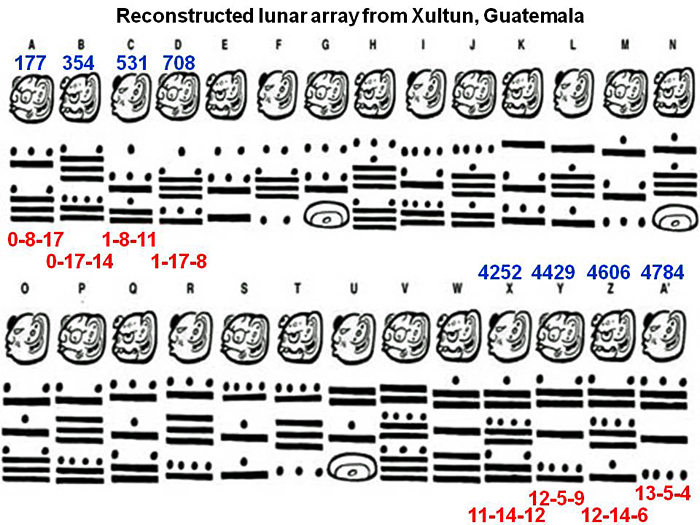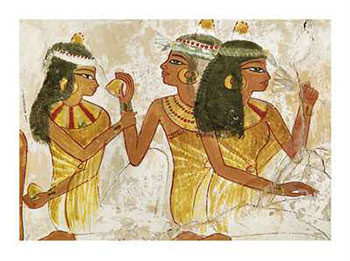- Reminder: turn off your rectangles!
- You have an assignment, due today.
We were looking at this Mayan lunar calendar:

"The Maya also made their own very accurate measurement of the solar year, putting it at 365.242 days. The latest computations give us the figure of 365.242198: so the Maya were actually far nearer the true figure than the current Western calendar of 365 days (which, with leap years, gives a true average of 365.2425)." From The Universal History of Numbers, by George Ifrah.
How can we make sense of the numbers that are appearing?
- How would the Mayans write the number we call 1729?
- I'll write something in Mayan, and you tell me what it is in our number system.
- What distinguishes the Mayans from the Babylonians?
- Let's do a few examples with Mayan numbers: write
- 37 in Mayan
- 694 in Mayan
- 1034 in Mayan

(I underline "distinct" because you cannot repeat powers: otherwise you could write, for example,
| 1 | 321 | |
| 2 | ||
| 4 | ||
| 8 | ||
| 16 | ||
| 32 | ||
| 64 | ||
| 128 | Too big! |
Now add up those rows marked with an asterix (*), and you'll get the answer (35952).
- 43*16
- 21*79
- fractions -- binary decimals, oh Ra!
- First of all, division is just multiplication backwards, right?
Let's look at the simplest example imaginable: divide 32 by 8. We can actually do it by Egyptian multiplication, since 8 divides into 32 evenly:
1 8 2 16 4 32 * So the answer is 4 (how do we get 4?)
- Similarly we could divide 40 by 8, using the same
table (again easy, since 8 divides into 40 evenly):
1 8 * 2 16 4 32 * So the answer is 5 (how do we get 5?)
- When the denominator doesn't divide the numerator
evenly, fractions make it more interesting:
Let's look at an example: divide 35 by 8.
In a way we turn it into a multiplication problem: what times 8 equals 35? So we know the 8, and use it to "double" -- but then to "halve", when 8 won't go evenly into 35:
1 8 2 16 4 32 * 1/2 4 1/4 2 * 1/8 1 * So the answer is 4+1/4+1/8
(Where have we seen those fractions before? Look to the Eye of Horus!)
- the Egyptians restricted
themselves to the so-called "unit fractions", which are
fractions of the form 1/m:
unit
fraction table, which is found on the Rhind
Papyrus (which dates to around 1650 BCE).
But they didn't restrict themselves to "halving", as our next example shows. Divide 6 by 7:
1 7 1/2 3+1/2 * 1/4 1+1/2+1/4 * 1/7 1 1/14 1/2 * 1/28 1/4 * So the answer is 1/2+1/4+1/14+1/28
- Why did
Egyptians do things this way? (an example division problem, using binary)
Dominic Olivastro, "Ancient Puzzles", suggests a third reason why this use of unary fractions is good. Consider the problem Ahmes poses of dividing 3 loaves of bread between 5 people. We would answer "each person gets 3/5-ths of a loaf". If we implemented our solution, we might then cut 2 loaves into 3/5 | 2/5 pieces, with bread for 3 people; then cut one of the smaller pieces in half, giving the other two people 2/5 + 1/5 pieces. Mathematically acceptable, but try this with kids and they will insist that it is not an even division. Some have larger pieces, some have smaller. Ahmes would calculate 3/5 as : 3/5 = ()3 + ()5 + ()15 [ = 1/3 + 1/5 + 1/15 ] Now cut one loaf into fifths, cut two more into thirds, then take one of the 1/3-rd pieces and cut it into 5-ths (for the 1/15-th pieces), and you can now distribute everyone's 3/5-ths share in a way that _looks_ equal, since they will have exactly the same size pieces. (And no, I don't want to argue about the crust.)
- Here's a relatively easy one: Suppose Fatima had 3
loaves to share between 4 people. How would she do it?
(Think about what the answer means, in terms of bread.)
- A little trickier:
- How would you divide 5 by 7?
- How can we use the unit fraction table to get the same answer?
- How would you like to do story problems like this one?!